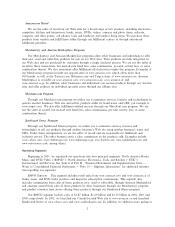Amazon.com 2002 Annual Report Download - page 21
Download and view the complete annual report
Please find page 21 of the 2002 Amazon.com annual report below. You can navigate through the pages in the report by either clicking on the pages listed below, or by using the keyword search tool below to find specific information within the annual report.focus on, the local customer, as well as their more established local brand name recognition. In addition,
governments in foreign jurisdictions may regulate e-commerce or other online services in such areas as
content, privacy, network security, copyright, encryption, taxation or distribution. We may not be able to
hire, train, retain, motivate and manage required personnel, which may limit our growth in international
market segments.
We Face SigniÑcant Inventory Risk
We are exposed to signiÑcant inventory risks as a result of seasonality, new product launches, rapid
changes in product cycles and changes in consumer tastes with respect to our products. In order to be
successful, we must accurately predict these trends and avoid overstocking or under-stocking products.
Demand for products, however, can change signiÑcantly between the time inventory is ordered and the
date of sale. In addition, when we begin selling a new product, it is particularly diÇcult to forecast product
demand accurately. A failure to optimize inventory within our fulÑllment network will harm our shipping
margins by requiring us to make split shipments from one or more locations, complimentary upgrades and
additional long-zone shipments necessary to ensure timely delivery. As a result of our Merchants@
program relationships with Toysrus.com, Babiesrus.com, Target and other companies, these parties identify,
buy, manage and bear the Ñnancial risk of inventory obsolescence for their corresponding stores and
merchandise. As a result, if any of these parties fail to forecast product demand or optimize inventory, we
would receive reduced service fees under the agreements and our business and reputation could be harmed.
The acquisition of certain types of inventory, or inventory from certain sources, may require signiÑcant
lead-time and prepayment, and such inventory may not be returnable. We carry a broad selection and
signiÑcant inventory levels of certain products, such as consumer electronics, and we may be unable to sell
products in suÇcient quantities or during the relevant selling seasons.
Our ability to receive inbound inventory eÇciently or ship completed orders to customers may be
negatively aÅected by a number of factors, including dependence on a limited number of shipping
companies, inclement weather, Ñre, Öood, power loss, earthquakes, labor disputes, acts of war or terrorism
or acts of God.
Any one of the inventory risk factors set forth above may adversely aÅect our operating results.
If We Do Not Successfully Optimize and Operate Our FulÑllment Centers, Our Business Could Be
Harmed
If we do not successfully operate our fulÑllment centers, it could signiÑcantly limit our ability to meet
customer demand. Because it is diÇcult to predict sales volume, we may not manage our facilities in an
optimal way, which may result in excess or insuÇcient inventory, warehousing, fulÑllment and distribution
capacity. In addition, third parties either drop-ship or otherwise fulÑll an increasing portion of our
customers' orders, and we are increasingly reliant on the reliability, quality and future procurement of their
services. Finally, under some of our commercial agreements, we maintain the inventory of other companies
in our fulÑllment centers, thereby increasing the complexity of tracking inventory in and operating our
fulÑllment centers. Our failure to properly handle such inventory or the inability or failure of these other
companies to accurately forecast product demand would result in unexpected costs and other harm to our
business and reputation.
We May Not Be Able to Adequately Protect Our Intellectual Property Rights or May Be Accused of
Infringing Intellectual Property Rights of Third Parties
We regard our trademarks, service marks, copyrights, patents, trade dress, trade secrets, proprietary
technology and similar intellectual property as critical to our success, and we rely on trademark, copyright
and patent law, trade secret protection, and conÑdentiality and/or license agreements with our employees,
customers, partners and others to protect our proprietary rights. EÅective trademark, service mark,
12
























